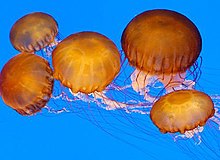
Back Neteldier AF لاسعات Arabic لاسعات ARZ Cnidaria AST Dalayıcılar AZ Сағыусылар BA Жыгучыя BE Мешести Bulgarian নিডারিয়া Bengali/Bangla Knidaried BR
| Cnidaria Temporal range: Ediacaran–Present
| |
|---|---|

| |
Four examples of cnidaria (clockwise, from top left):
| |
| Scientific classification | |
| Domain: | Eukaryota |
| Kingdom: | Animalia |
| Subkingdom: | Eumetazoa |
| Clade: | ParaHoxozoa |
| Phylum: | Cnidaria Hatschek, 1888 |
| Subphyla and classes[3] | |
| |

Cnidaria (/nɪˈdɛəriə, naɪ-/ nih-DAIR-ee-ə, NY-)[4] is a phylum under kingdom Animalia containing over 11,000 species[5] of aquatic invertebrates found both in fresh water and marine environments (predominantly the latter), including jellyfish, hydroids, sea anemones, corals and some of the smallest marine parasites. Their distinguishing features are an uncentralized nervous system distributed throughout a gelatinous body and the presence of cnidocytes or cnidoblasts, specialized cells with ejectable flagella used mainly for envenomation and capturing prey. Their bodies consist of mesoglea, a non-living, jelly-like substance, sandwiched between two layers of epithelium that are mostly one cell thick. Cnidarians are also some of the few animals that can reproduce both sexually and asexually.
Cnidarians mostly have two basic body forms: swimming medusae and sessile polyps, both of which are radially symmetrical with mouths surrounded by tentacles that bear cnidocytes, which are specialized stinging cells used to capture prey. Both forms have a single orifice and body cavity that are used for digestion and respiration. Many cnidarian species produce colonies that are single organisms composed of medusa-like or polyp-like zooids, or both (hence they are trimorphic). Cnidarians' activities are coordinated by a decentralized nerve net and simple receptors. Cnidarians also have rhopalia, which are involved in gravity sensing and sometimes chemoreception. Several free-swimming species of Cubozoa and Scyphozoa possess balance-sensing statocysts, and some have simple eyes. Not all cnidarians reproduce sexually, but many species have complex life cycles of asexual polyp stages and sexual medusae stages. Some, however, omit either the polyp or the medusa stage, and the parasitic classes evolved to have neither form.
Cnidarians were formerly grouped with ctenophores, also known as comb jellies, in the phylum Coelenterata, but increasing awareness of their differences caused them to be placed in separate phyla.[6] Cnidarians are classified into four main groups: the almost wholly sessile Anthozoa (sea anemones, corals, sea pens); swimming Scyphozoa (jellyfish); Cubozoa (box jellies); and Hydrozoa (a diverse group that includes all the freshwater cnidarians as well as many marine forms, and which has both sessile members, such as Hydra, and colonial swimmers (such as the Portuguese man o' war)). Staurozoa have recently been recognised as a class in their own right rather than a sub-group of Scyphozoa, and the highly derived parasitic Myxozoa and Polypodiozoa were firmly recognized as cnidarians only in 2007.[7]
Most cnidarians prey on organisms ranging in size from plankton to animals several times larger than themselves, but many obtain much of their nutrition from symbiotic dinoflagellates, and a few are parasites. Many are preyed on by other animals including starfish, sea slugs, fish, turtles, and even other cnidarians. Many scleractinian corals—which form the structural foundation for coral reefs—possess polyps that are filled with symbiotic photo-synthetic zooxanthellae. While reef-forming corals are almost entirely restricted to warm and shallow marine waters, other cnidarians can be found at great depths, in polar regions, and in freshwater.
Cnidarians are a very ancient phylum, with fossils having been found in rocks formed about 580 million years ago during the Ediacaran period, preceding the Cambrian Explosion. Other fossils show that corals may have been present shortly before 490 million years ago and diversified a few million years later. Molecular clock analysis of mitochondrial genes suggests an even older age for the crown group of cnidarians, estimated around 741 million years ago, almost 200 million years before the Cambrian period, as well as before any fossils.[8] Recent phylogenetic analyses support monophyly of cnidarians, as well as the position of cnidarians as the sister group of bilaterians.[9]
- ^ Classes in Medusozoa based on "ITIS Report – Taxon: Subphylum Medusozoa". Universal Taxonomic Services. Retrieved 2018-03-18.
- ^ Cite error: The named reference
Collinswas invoked but never defined (see the help page). - ^ Subphyla Anthozoa and Medusozoa based on "The Taxonomicon – Taxon: Phylum Cnidaria". Universal Taxonomic Services. Archived from the original on 2007-09-29. Retrieved 2007-07-10.
- ^ "cnidaria". Oxford English Dictionary (Online ed.). Oxford University Press. (Subscription or participating institution membership required.)
- ^ "WoRMS - World Register of Marine Species". www.marinespecies.org. Retrieved 2018-12-17.
- ^ Dunn, Casey W.; Leys, Sally P.; Haddock, Steven H.D. (May 2015). "The hidden biology of sponges and ctenophores". Trends in Ecology & Evolution. 30 (5): 282–291. Bibcode:2015TEcoE..30..282D. doi:10.1016/j.tree.2015.03.003. PMID 25840473.
- ^ E. Jímenez-Guri; et al. (July 2007). "Buddenbrockia is a cnidarian worm". Science. 317 (116): 116–118. Bibcode:2007Sci...317..116J. doi:10.1126/science.1142024. PMID 17615357. S2CID 5170702.
- ^ Park E, Hwang D, Lee J, et al. (January 2012). "Estimation of divergence times in cnidarian evolution based on mitochondrial protein-coding genes and the fossil record". Molecular Phylogenetics & Evolution. 62 (1): 329–45. Bibcode:2012MolPE..62..329P. doi:10.1016/j.ympev.2011.10.008. PMID 22040765.
- ^ Zapata F, Goetz FE, Smith SA, et al. (2015). "Phylogenomic Analyses Support Traditional Relationships within Cnidaria". PLOS ONE. 10 (10): e0139068. Bibcode:2015PLoSO..1039068Z. doi:10.1371/journal.pone.0139068. PMC 4605497. PMID 26465609.